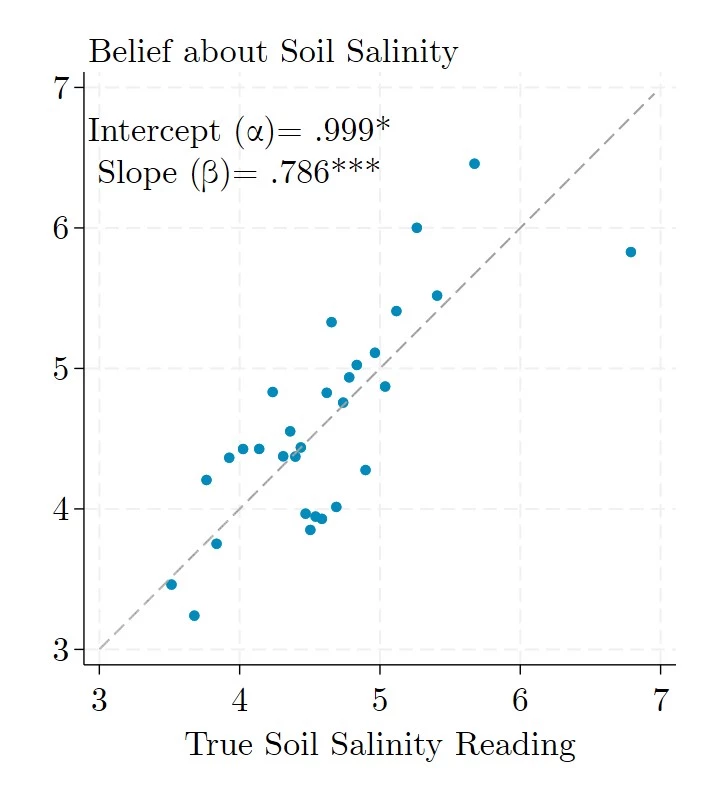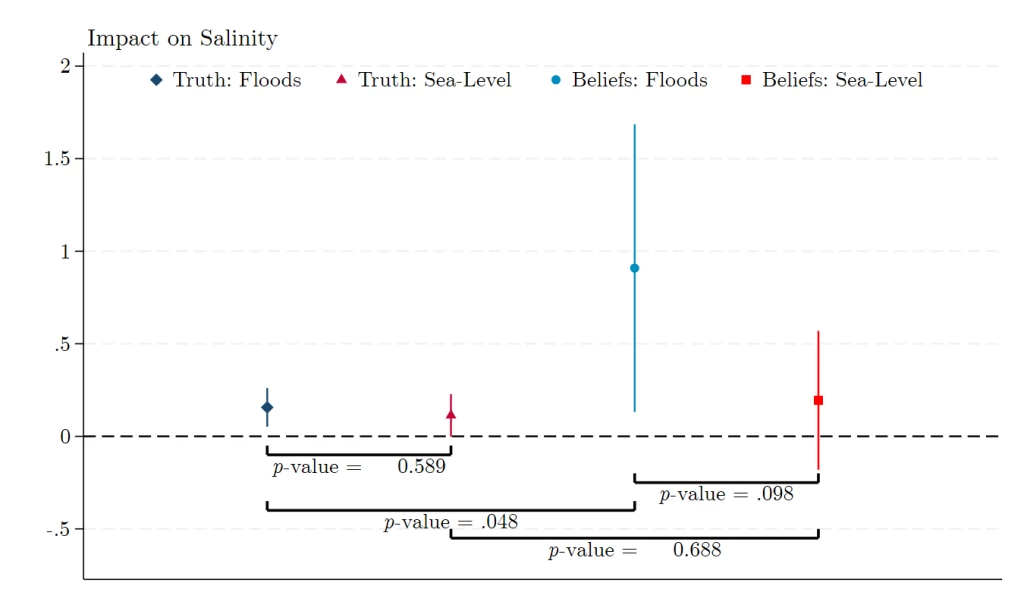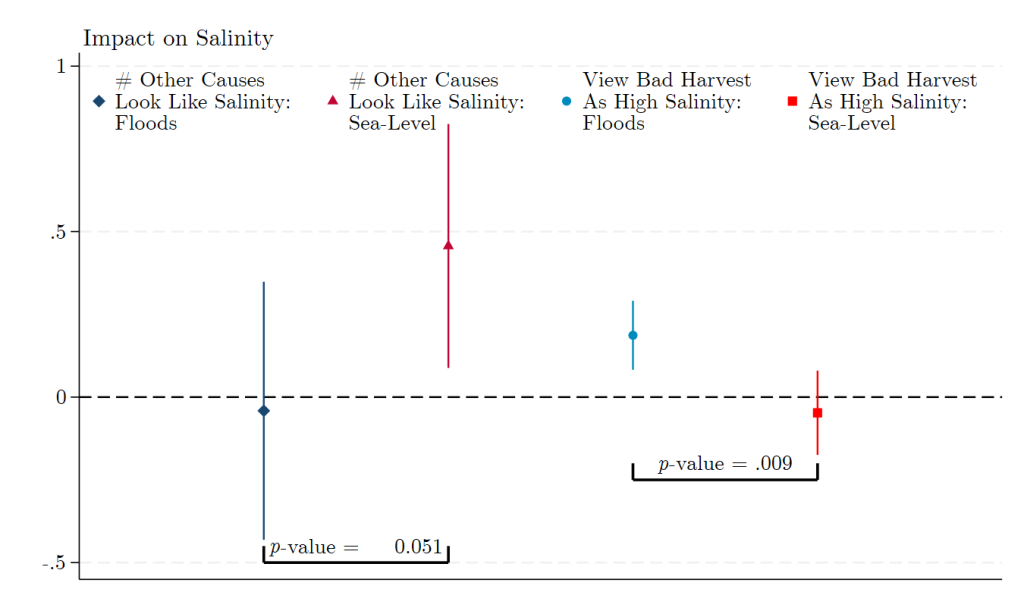This is the fourth in this year’s series of posts by PhD students on the job market.
Global warming poses an existential threat, especially to the 600 million small-holder farmers whose livelihoods directly depend on the climate. To mitigate these dangers, individuals must adapt to the evolving world around them, a task which requires forming accurate beliefs about the local environment. Yet learning about the climate can present significant challenges amid the subtle shifts (e.g., rising sea levels infiltrating groundwater) and salient shocks (e.g., salt-water floods) characteristic of a warming planet.
In my Job Market Paper, I study how farmers learn about the environment, and how these beliefs impact their adaptation to climate change. My study takes place in Bangladesh, ground zero for the most harmful consequences of global warming. I primarily focus on rice farmers forming beliefs about soil salinity, a growing environmental issue that threatens 30 percent of irrigated land worldwide. Perceptions about salt levels directly enter into agricultural decision-making as farmers decide whether or not to plant salinity-tolerant varieties, which grow better than alternative seeds in high salt conditions but relatively worse in low ones.
I first find that on average, farmers hold remarkably correct beliefs about soil salinity on their plots, though this overall accuracy masks significant heterogeneity. I use a visual method to elicit precise, probabilistic beliefs about soil salinity from 2,279 farmers across 250 villages. To compare these beliefs to the truth, I use agronomic sensors to directly measure the salt content on farmers’ own plots. Figure 1 plots a binned scatter plot of farmers’ beliefs against the agronomic truth. In a regression, I cannot reject that the intercept equals 0 and the slope equals 1 at the 5 percent level: in other words, on average farmers’ expectations closely track the actual amount of soil in their land. The vast majority of variation in beliefs is left unexplained, however, with most farmers significantly over- or underestimating salt content.

I show that these gaps between soil salinity beliefs and the truth reflect more than just elicitation noise. First, these errors strongly predict actual planting behavior: farmers who overestimate salinity more also plant more salinity-tolerant seeds. Second, farmers whom we might expect to be better at learning about soil conditions also hold more accurate beliefs: those with more land, more experience, and viewed as higher skilled by their neighbors. I show similar patterns of beliefs with respect to flooding and monsoon intensity, two other important dimensions of climate change in this setting.
These findings raise an important puzzle: given the strong incentives to learn the truth, how can these errors persist in equilibrium? I build a simple model of belief formation amid climate change to provide one potential answer. Guided by the results of narrative qualitative interviews and open-ended questions with my main sample, the model features farmers who—given a lack of access to direct measurement technology—infer environmental conditions by observing the output of their harvest and physical characteristics of their crops. The number of potential factors impacting yield exceeds the set of signals from which farmers can learn, creating a fundamental identification problem (Acemoglu, Chernozkhukov, and Yildiz, 2016). A farmer observing low yield, for example, cannot distinguish between high soil salinity and inappropriate fertilizer use as the root cause. As a result, I show that Bayesian farmers with arbitrarily small differences in initial beliefs can nevertheless fail to converge to agreement about their local environment, even after receiving an infinite number of common signals. This gap occurs because priors about which environmental features matter endogenously shape the interpretation of new data, leading to a form of confirmation bias. For example, a farmer who initially expects soil salinity to be high will (rationally) interpret a bad harvest as evidence of too much salt, even if another factor might actually be the culprit.
How does global warming shape this belief formation process? I focus on how farmers learn from two classes of signals characteristic of climate change: salient shocks and subtle shifts in the environment. In the case of soil salinity, experiencing a flood with saline water (perhaps due to a tidal surge, for instance) constitutes a salient shock by drawing farmers’ attention to the salt that has just been deposited onto the plot’s surface. By contrast, rising sea levels that cause the intrusion of ocean water into a farmer’s irrigation source subtly shift soil salinity. The theoretical framework predicts that these two classes of environmental events will generate different impacts on learning by changing how farmers learn from new data.
I test these predictions using two quasi-random natural experiments. To capture salient shocks, I study flooding with saline water, the modal environmental event farmers recall impacting salt levels on their study. To overcome biased coverage in existing flooding datasets, I develop a new measurement approach combining methods from machine learning and geophysics in the analysis of satellite data. (I describe this technique as well as analyze the consequences of flooding and how households adapt in a separate paper.) I adopt a difference-in-differences design comparing villages that experienced a differentially saltier flood. To capture subtle shifts, I study the contamination of irrigation water through rising sea levels. I use satellite data to measure shocks to ocean elevation and salinity and estimate a triple difference-in-differences specification comparing villages that happen to experience higher, saltier sea levels and are closer to the coast.
Figure 2 presents the main results of these natural experiments, plotting only the main interaction terms from these difference-in-differences regressions. The salient shock and subtle shift happen to have equivalent effects on the salinity levels on farmers plots, as measured by the agronomic sensors (the blue diamond and red triangle). Yet the impacts on farmers’ beliefs are remarkably asymmetric across events, with only the salty floods causing farmers to increase their expectations about salinity on their land (blue circle and red square). To put the magnitude of these effects into perspective, a 1 s.d. saltier flood increases soil salinity beliefs .75 dS/m more than it increases true salinity, equivalent to .26 s.d. of the belief distribution and 1.1 s.d. of the true soil distribution.

Consistent with the mechanisms of the model, I combine these natural experiments with a lab-in-the-field elicitation and other survey questions to show that farmers interpret the same physical characteristics of rice plants differently depending on their past environmental experience. Figure 3 plots the main interaction terms from these specifications. Farmers exposed to a subtle increase in salinity list a higher number of alternative explanations that give the same symptoms as too much salt, while those experiencing flooding with saltier water experience no such effects. By contrast, those who experience a salient shock in the form of a salty flood are significantly more likely to interpret a bad harvest as a sign of high salinity, while those undergoing a subtle intrusion into their groundwater do not differentially process that symptom.

In the final parts of my paper, I combine large-scale field experiments and structural modeling to show that these environmental beliefs matter for farmers economic well-being and suggest policy interventions. I randomly provide farmers with information about salt levels on their land and show that this treatment has significant impacts on their demand for salinity-tolerant seeds. In a separate experiment offering these seeds for free, I show that this decision has large consequences for agricultural profits. Using the experimental variation to discipline a structural model of seed choice, I show that moving from the 10th to the 90th percentile of salinity belief errors increases take-up of salinity-tolerant seeds by 81%. Since the price of salinity tolerant seeds is approximately equal to the price of alternative varieties, the cost of these seeds is unlikely to be an important binding constraint to adoption. Instead, the results show that environmental beliefs play a major role above and beyond other determinants of demand.
Finally, I show that this soil information intervention presents a promising policy solution at scale. The sensors I use to measure salinity are relatively cheap (though currently unavailable locally to farmers), costing approximately $30 USD. Using an incentivized willingness-to-pay measure, I show that farmers are willing to pay about $0.37 USD on average for information about last season’s salinity. This provides a lower bound on demand for salt levels measured just prior to planting. Two features of the setting make this intervention extremely cost-effective. First, the sensors are public goods and can be used to measure many farmers’ plots. Second, the spatial covariance of salinity is quite high, so instead of measuring salt levels on each farmer’s individual plot, one can simply measure a few in each geographic area. To examine the feasibility of distributing this aggregate information instead of personalized data, I embed a second arm into my information experiment that only offers farmers the average soil salinity for their upazila, an area of approximately 90 villages. I find that farmers value the salinity information about their local area just as much as information about their own specific plot, and this broader treatment has, if anything, larger effects on behavior. As a result, policymakers can have significant impacts on farmers’ adaptation to climate change without having to visit every individual plot to collect data, suggesting one cost-effective way to mitigate the damages of global warming to the rural poor.
Dev Patel is a Ph.D. student at Harvard University.


Join the Conversation